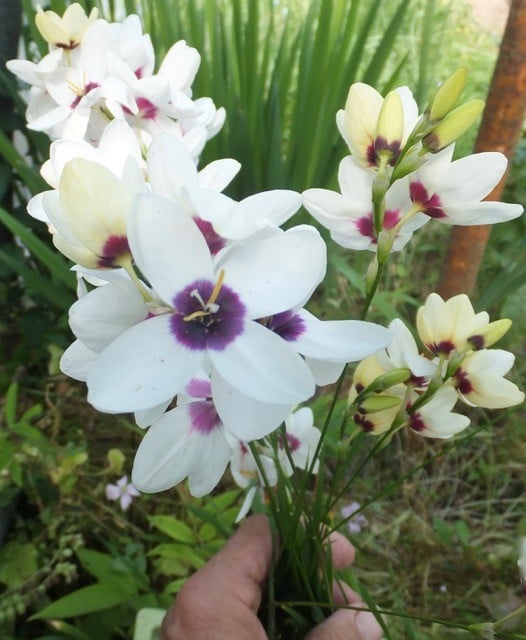
For a frost free greenhouse African Corn Lilies are one of the easier tender spring flowers to grow for cutting though left they make a grand display over many weeks. Ixias have been popular in the U.S.A. and other countries since these were first introduced from South Africa a couple of centuries ago yet have remained relatively unknown in the U.K. This despite their standing for so long as cut flowers and some (mostly the whiter and yellow ones) having delightful scent.
You could start with seed and these will bloom in a few years however this is not widely available and as flowering size corms are inexpensive so order some straightaway. You pot Ixias in batches from late autumn till late-winter to get a succession of blooms, though the best results usually come from those started before Christmas.
Ixias like a free draining, sandy, leaf mould rich compost and can be set a dozen or so in a 5l tub. Watering has to be just sufficient to moisten the compost initially but then as the top growth shows can be increased. Always use warmed rain water and never waterlog. A little liquid feed can be added but sparingly as these are not hungry plants.
The long thin leaves and later the flowering stems do not need, but will benefit from, canes and strings to keep them upright, though fortunately these do not flop quite as wantonly as Freesias.
Although tender Ixias do not like hot conditions so are quite happy in a cool greenhouse or a sunny bay window, around 45-50°F /8-10°C is their preferred temperature range. It is light they crave, and although it seems extravagant adding a special LED source will dramatically improve results. This especially so when they are blooming as these flowers open with bright sun.
After flowering has finished and the leaves die back let the compost dry out completely. Ideally remove the corms and keep these in a safe dry place. However I leave mine in the tubs of dried out compost over summer then start them into growth again in late autumn / early winter. Initially just moisten their compost, I stand the container in warm water until the surface starts to darken then drain, once growth resumes watering more freely again.
For the connoisseur there are about forty species known, though only a half dozen in twenty varieties are widely available, worth looking for is the striking, almost artificial looking, turquoise green I. viridiflora.


